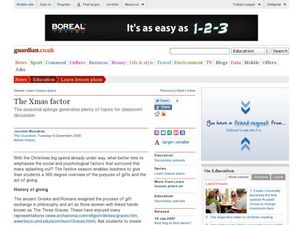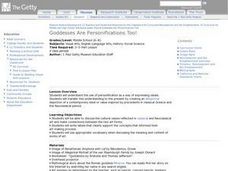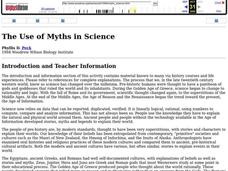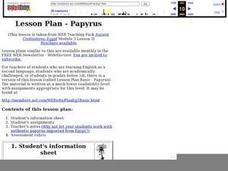Curated OER
The Xmas Factor
Young scholars examine the mass marketing of Christmas. In this gift giving lesson, students visit selected websites to discover the history behind gift-giving, research marketing techniques, and consider giving alternative gifts.
Curated OER
Goddesses are Personifications Too!
Students analyze the use of personification in classical Greek art and the Neoclassical period. For this Neoclassical art lesson, students discuss the cultural values reflected in classical and Neoclassical. Students define a core value...
Curated OER
Goddesses Are Personifications Too!
Students discover the use of personification as a way of expressing ideals. In this Language Arts lesson, students create an allegorical depiction of a contemporary ideal. Students write labels that clearly support the concepts that...
Curated OER
Romanticism: A Movement Across the Arts
Characterized by the five I's (imagination, intuition, idealism, inspiration, and individuality), the Romantic period saw quite a shift in the music and art production at its time. Review this PowerPoint with your class to discuss some...
Curated OER
Renaissance and Reformation Chapter Test
This is a traditional textbook chapter test on the Renaissance and Reformation, complete with eight multiple choice questions, six fill-in-the-blank, and a 10-question matching section identifying key individuals and terms from the...
Curated OER
Referencing the Classical Past
Students explore the concept of myths conveyed through art. In this art history activity, students examine "Three Goddesses" and discuss the state of the world at the time that Nollekens created the sculptures as they analyze the pieces.
Curated OER
The Use of Myths in Science
Students are told stories, myths and legend to explain their world. After telling the tales and discussion them, students are assigned to write a myth that describes a familiar situation, such as why the school garbage cans are always...
Curated OER
The Use of Myths in Science
Students examine folk tales to determine the basis for scientific myths. They demonstrate through the discussion of the folk tales that the perception of the world has changed as new information is gained. They write their own folk...
Curated OER
The Art of Studying Art
Students explain the value of different genres of art. In this art lesson, students describe the differences in various genres of art and make comparisons between them. Students choose an art genre and create an original work of art...
Curated OER
Middle Ages Timeline
Students research a historical figure from the Middle Ages. In this Middle Ages lesson, students present important events of their characters life and of the time. Students write a time card for each significant event. Students must...
Curated OER
Constructing a Wardrobe
Sixth graders compare and contrast storage spaces of the past and present. They examine how furniture tells us how people lived, and work in pairs to design and construct a contemporary wardrobe that fits their personal needs.
Curated OER
Papyrus
Students study what papyrus was and what it was used for. Students explore how papyrus was made, and the two writing systems hieroglyphics and cuneiform.
Curated OER
Hatshepsut's Temples and Obelisks
Third graders create Hatshepsut's Temples and Obelisks using a variety of materials.
Curated OER
Explorit's Green Salad Quiz
In this food history worksheet, students read the information about the history of food and salads. Students select the correct answer for the 6 related questions.
Curated OER
Referencing the Classical Past
Learners discuss the sculptural group of Three Goddessesby Joseph Nollekens in a study of the classical past. In this Classical history lesson, students describe the three figures in the painting and read an excerpt for the story the art...
Curated OER
Guidelines for Governing: Utopia and The Prince
Students explore the power of the Church in government. In this literature lesson, students read Sir Thomas More's Utopia and Niccolo Machiavelli's The Prince. Students respond to questions regarding the works and discuss them.
Curated OER
Introduction to Greek Theatre
Students create a tableau for a Greek myth. In this introduction to Greek theatre instructional activity, students discuss the history of Greek theatre and tableau and complete a handout. Students work in groups to choose a myth and...
Curated OER
Microbes & History: Microbial influence on the spread of Civilization
Young scholars explore how to extract plant fibers from the flax plant Linum usitatissimum in the process of making linen fibers. Doing so spark interest in the importance of microbial action on the spread of human culture and civilization.
Curated OER
Pumpkin Seeds Mosaic
Pupils examine the history of mosaics. They follow instructions to create their own pumpkin seed mosaic. They also bake some of the seeds to enjoy as a treat.
Curated OER
CSAP Preparation: "Strike While the Iron is Hot"
Students survey several concepts in literature, science, history, and geography as a preparation for the CSAP standardized testing experience. This nine lesson unit provides exposure to the format and content of the test.
Curated OER
Who are American Citizens?
Students investigate American citizenship. In this civics lesson plan, students consider the basic knowledge of U. S. government new citizens are required to have. Students also examine the 14th amendment that describes U. S. citizenship.
Curated OER
Primary History: Viking Family Life
In this Viking history worksheet, students complete 3 extension activities that help them learn about Viking family life. Students write about the life of a Viking slave, research the life of Viking children, and make a list of the...
Khan Academy
Khan Academy: Greco Roman
Instead of rule by a single person, Athens and Rome developed governments with widespread participation by male elites, which lasted about 170 years in Athens and about 480 years in Rome. This article discusses the rise of the Greek and...

























